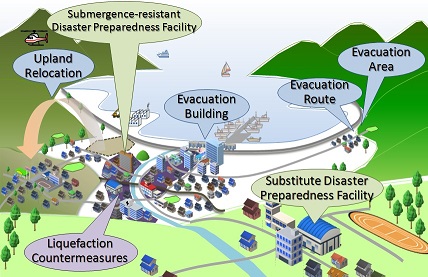|
 Research on Technologies for Disaster Reduction Planning in Coastal Cities (FY2012-2014)
Research on Technologies for Disaster Reduction Planning in Coastal Cities (FY2012-2014)
|
In coastal cities & towns where fear for similar disasters & damages as those of the Tohoku Pacific Offshore Earthquake has grown, there are urgent necessity for countermeasures, such as for smooth evacuation of citizens, sustainability of urban disaster preparedness functions and against housing area liquefaction. These urban disaster mitigation measures should be reflected in the disaster mitigation strcuturing plan of the city and towns.
For this reason, the following research is being conducted under a three-year plan since FY2012, with a mission to develop a planned method and technical data required for Japan’s technical guidelines and technical standards on promotion of disaster mitigation structuring, including countermeasures against tsunami and widespread land liquefaction in coastal cities & towns facing risk of massive earthquakes in future.
-
Urban development planning method based on evacuation safety
A multi-agent tsunami evacuation simulator is developed to predict the evacuation behavior of residents in various disaster scenarios.
In addition, this simulator can be used in identifying districts which would have many people who have trouble evacuating and districts with insufficient evacuation areas, and extracting important evacuation routes, to establish a method of drafting the urban development plan for improving evacuation safety of residents.
-
Planning method to secure redundancy of urban disaster preparedness functions
For disaster preparedness facilities such as local government offices, shelters, medical and emergency facilities, firefighting and rescue facilities, methods of planning their locations, designating alternate facilities, linking facilities, and anti-flooding measures are studied. The aim is to ensure their essential funcitions in the required phases leading to post-disaster emergency correspondence, recovery and restoration for the entire city & towns, although some of the facilities may be damaged and temporarily fail, depending on the form and intensity of the disaster such as tsunami.
-
Data preparation for technical standardization of liquefaction measures
The basic data on specific target levels (such as index of allowable settlement) corresponding to the establishment of targeted required performance was collected and prepared, to establish the numerical criteria for housing land disaster prevention. Also the basic data was analyzed and prepared for setting the specification standards for each ground characteristics and construction method.

An Image of Disaster Reduction Planning in Coastal Cities
|
 Research on Measures for Fire Spread Prevention Needed for Future Urban Fire Prevention (FY2012-2013)
Research on Measures for Fire Spread Prevention Needed for Future Urban Fire Prevention (FY2012-2013)
|
|
 Study on Preservation and Reproduction Measures of the View from Parks and Green Spaces (FY2011-2015)
Study on Preservation and Reproduction Measures of the View from Parks and Green Spaces (FY2011-2015)
|
|
 Comparative Study on Urban Shrinkage Methods for Compact Urban Form
(FY2011-2013)
Comparative Study on Urban Shrinkage Methods for Compact Urban Form
(FY2011-2013)
|
Taking into acount the future decline of population and the current spread of urban area in Japanese local cities, it seems inevitable to study the way to shrink suburban area in some cities, to achieve urban sustainability by realization of "consolidated urban structure." Thus, the aim of this research is to study the procedures and implementation scenarios of systematic urban shrinkage, and make a comparative study between the scenarios by advantage (especially of costs and enviromental loads), operability, and applicability.
|
|
|
All Rights Reserved, Copyright (C) 2001, National Institute for Land
and Infrastructure Management
| |
